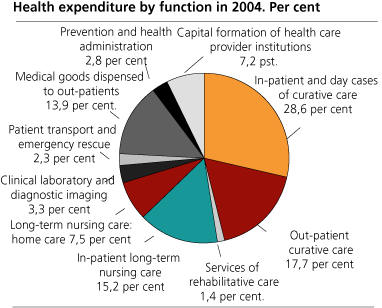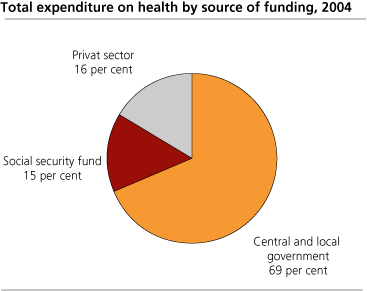Content
Published:
This is an archived release.
NOK 36 000 spent on health care per capita
Total expenditure on health in Norway amounted to NOK 168 billion in 2004, or NOK 36 000 per capita. As a percentage of gross domestic product (GDP), the health expenditure rose from 8.5 per cent in 1997 to 10 per cent in 2004. Public sector spending on health accounted for about 84 per cent of the total.
The health accounts for the 1997 to 2004 period show that health expenditure per capita increased from NOK 21 000 in 1997 to NOK 36 000 in 2004. Health expenditures as a proportion of GDP varied between 8.5 per cent and 10.3 per cent. The relatively large variations over time reflect fluctuations in the price of oil. In years with a relatively high oil price the GDP ratio will decline compared to more normal years. If we take this into account and look at the GDP ratio for mainland Norway, the ratio increased from slightly above 10 per cent in 1997 to almost 13 per cent in 2004.
Health figures for other OECD countries .
| Total expenditure on health. 1997-2004. NOK million |
| 1997 | 1998 | 1999 | 2000 | 2001 | 2002 | 2003* | 2004* | ||||||||||||||||||||||||||||||||
|---|---|---|---|---|---|---|---|---|---|---|---|---|---|---|---|---|---|---|---|---|---|---|---|---|---|---|---|---|---|---|---|---|---|---|---|---|---|---|---|
| Total current expenditure on health. NOK million | 88 373 | 98 021 | 106 766 | 116 232 | 125 488 | 140 501 | 149 255 | 155 853 | |||||||||||||||||||||||||||||||
| HC R.1 Capital formation of health care provider institutions. NOK million | 5 635 | 7 480 | 8 945 | 8 496 | 9 778 | 9 528 | 11 564 | 12 042 | |||||||||||||||||||||||||||||||
| Total expenditure on health. NOK million | 94 008 | 105 500 | 115 711 | 124 728 | 135 266 | 150 029 | 160 819 | 167 894 | |||||||||||||||||||||||||||||||
| Total expenditure on healt in current prices in per cent of GDP | 8.5 | 9.3 | 9.4 | 8.5 | 8.9 | 9.9 | 10.3 | 9.9 | |||||||||||||||||||||||||||||||
| Total expenditure on health in current prices in per cent of GDP Mainland Norway | 10.4 | 10.8 | 11.2 | 11.3 | 11.6 | 12.4 | 12.9 | 12.8 | |||||||||||||||||||||||||||||||
| Total expenditure on healt in current prices per capita | 21 340 | 23 807 | 25 933 | 27 773 | 29 968 | 33 059 | 35 230 | 36 563 | |||||||||||||||||||||||||||||||
| Total expenditure on health at constant NOK in 2000 per capita | 24 606 | 25 781 | 27 233 | 27 773 | 28 564 | 30 722 | 31 072 | 31 236 | |||||||||||||||||||||||||||||||
Measured in constant prices the expenditure on health increased by slightly more than 4 per cent per year on average from 1997 to 2004. There was a particularly strong growth in gross capital formation, with an average growth rate of 9 per cent per year. This is due to several new political action plans and programmes for health care, and the building of a new national hospital (Rikshospitalet). There was also a large increase in expenditure on day cases of curative care, home nursing and pharmaceuticals.
Heath expenditure by function
Health expenditure by function - type of service and medical goods consumed - is presented in the figure "Health expenditure by function in 2004". Almost 30 per cent of the expenditure was allocated to in-patient and day cases of curative care. Out-patient curative care accounted for about 18 per cent, whereas in-patient long-term nursing care accounted for 15 per cent.
The table "Health expenditure by function in 1997 and 2004" shows the distribution of expenditure by main function. The distribution has been relatively stable over the period.
|
Health expenditure by function. 1997 and 2004.
Per cent |
| 1997 | 2004 | ||||||||||||||||||||||||||||||||||||||
|---|---|---|---|---|---|---|---|---|---|---|---|---|---|---|---|---|---|---|---|---|---|---|---|---|---|---|---|---|---|---|---|---|---|---|---|---|---|---|---|
| Total expenditure on health, HC 1:7 + R1 | 100.0 | 100.0 | |||||||||||||||||||||||||||||||||||||
| HC 1.1 In-patient curative care | 26.8 | 25.3 | |||||||||||||||||||||||||||||||||||||
| HC 1.2 Day cases of curative care | 2.3 | 3.4 | |||||||||||||||||||||||||||||||||||||
| HC 1.3-1.4 Out-patient curative care | 20.1 | 17.7 | |||||||||||||||||||||||||||||||||||||
| HC 2.1 Services of rehabilitative care | 1.5 | 1.4 | |||||||||||||||||||||||||||||||||||||
| HC 3.1 In-patient long-term nursing care | 14.7 | 15.2 | |||||||||||||||||||||||||||||||||||||
| HC 3.3 Long-term nursing care: home care | 6.1 | 7.5 | |||||||||||||||||||||||||||||||||||||
| HC 4.1 Clinical laboratory and diagnostic imaging | 3.5 | 3.3 | |||||||||||||||||||||||||||||||||||||
| HC 4.3 Patient transport and emergency rescue | 2.4 | 2.3 | |||||||||||||||||||||||||||||||||||||
| HC 5 Medical goods dispensed to out-patients | 14.0 | 13.9 | |||||||||||||||||||||||||||||||||||||
| HC 6-7 Prevention and health administration | 2.7 | 2.8 | |||||||||||||||||||||||||||||||||||||
| R:1 Capital formation of health care provider institutions | 6.0 | 7.2 | |||||||||||||||||||||||||||||||||||||
For curative care in hospitals there was a shift from in-patient to day cases during the period. Expenditure on in-patient and day cases of curative care amounted to about 29 per cent of the spending in the period. In addition, the table shows that expenditure on in-patient long-term nursing care increased less than expenditure on home nursing.
Financing
The figure "Total expenditure on health by source of funding, 2004" shows the distribution of public and private financing. Central government, local government and the social security fund are the public sources, while the private sources mainly consist of household out-of-pocket payments.
The two functions out-patient dental care and pharmaceuticals are the main components of private spending. For the public sector, in-patient and day cases of curative care is the largest expenditure group. Public sector spending on health accounted for about 84 per cent of the total in 2004, compared with 81 per cent in 1997. The reason for the decline in private funding in 2004 is that households finance a lower proportion of out-patient curative care, pharmaceuticals and long-term health care than in 1997.
|
Total expenditure on health measures the final consumption of health care goods and services (i.e. current health expenditures) in addition to capital investment in health care infrastructure. This includes spending by public and private sources (including households) on medical goods and services, public health, preventive health care programmes and administration. The two major components of total current health expenditure are expenditure on personal health care and expenditure on collective services. Personal health care services comprise curative care, rehabilitation, long-term health care, ancillary health care services, and medical goods dispensed to out-patients. Collective services comprise public health tasks such as health promotion and disease prevention services and health administration, which are delivered to society at large. Health expenditure also includes expenditure on health care and social services. According to international guidelines only expenditure for health care and social services that are health related should be included in the health accounts. Long-term nursing care is typically a mix of medical care and social care. Thus only the former is included here. The most important sources for compiling health expenditure are public accounts and statistics from public and private hospitals (specialist nursing homes, convalescence and rehabilitation institutions and hospitals). Health expenditure is defined according to the System of Health Accounts (OECD 2000). |
Tables:
- Table 1 Health expenditure, key figures. 1997-2004
- Table 2 Current expenditure on health, by function of care. 1997-2004. NOK million
- Table 3 Total current expenditure on health by function, distributed by source of funding. 2002. Per cent
- Table 4 Total current expenditure on health by function, distributed by source of funding. 2000. Per cent
- Table 5 Total current expenditure on health by function, distributed by source of funding. 1997. Per cent
- Table 6 Total current expenditure by provider distributed by source of funding. 2002. Per cent
- Table 7 Total current expenditure by provider distributed by source of funding. 1997. Per cent
- Table 8 Total current expenditure by function distributed by provider. 2002. Per cent
Contact
-
Eirik Larsen Lindstrøm
E-mail: eirik.lindstrom@ssb.no
tel.: (+47) 46 78 22 92


